

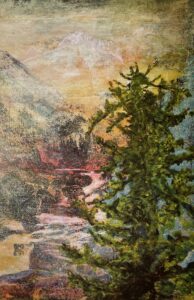
Nesting from the series Flower Serenade: A Gift of Time 2021
“Rita Robillard Time and Place”,
Hallie Ford Museum of Art, Salem Oregon
Tuesday to Saturday noon – 5pm Until March 25, 2023
Rita Robillard was a colleague of mine in the art department at Washington State University in Pullman in the 1980s. Later she moved to Portland State University and became chair of the department. We have remained close friends, partly because we have a common childhood experience growing up in downtown New York City. Here is a detail of a print she gave me of Gramercy Park where we both grew up. As you can see it is a gated park to which only people who lived on the park could gain access. As I remember it the park was hostile to children playing, so it was gated in more ways than one.
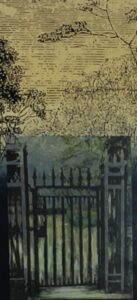
She declared at the opening that growing up in New York, where nature is scarce, led her to a love of nature and the outdoors. I feel the same way.
She moved from Manhattan to California, and then Brazil from 1971 to 1974.
The experience in Sao Paolo and in a rural village in Brazil was especially crucial. She learned new mythologies, as well as music and dance that have stayed with her all her life. She immersed herself in the luscious tropical environment as she taught art to children and also learned from them.
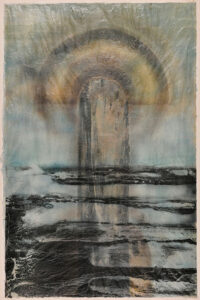
Above we see Heroes in the Seaweed, 1980 one of the works in the exhibition based on her experiences in Minas Gerais, Brazil near the Sumidouro River that “disappears under the earth to form a network of underground caves full of stalactites”
After returning from Brazil Robillard attended graduate school at University of California, Berkeley in the late 1970s early 1980s. Robillard responds to the “time and place” in Berkeley with a few geometric works, but soon shifts to evoking the luscious soft forms of the Sumidouro River which she describes as having “eerie beauty.”
She called this mystical and mysterious series “Spirit Ground.”
Robillard declares an affinity with the Northwest School mysticism with their emphasis on Asian Art techniques and philosophy. Ongoing study of Asian Art has been another focus throughout her career.
Robillard is a master printmaker.
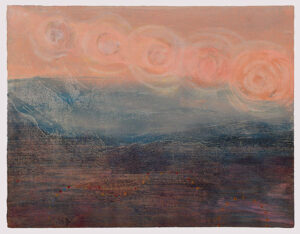
Doves in Space 2007 from the series Luminous Frontiers
The entire exhibition consists of prints some very large in scale, from multiple plates. Technically they range from etching and screen prints, to more complex processes that create subtle textures. In looking closely at her work, we can explore layers sinking deep into another world. The work Doves in Space, 2007 ( screenprint and colored pencil on paper) from the series Luminous Frontiers suggests some of those subtle textures.
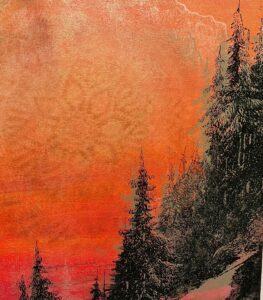
Orbs of the Forest II from the Series Waters of March 2019, screenprint and acrylic on panel
Some are views of a glowing sky imprinted with a lace pattern, and trees in the foreground. The lace pattern suggests a reference to early abstractions and patterns that connect to nature. It also includes her grandmother who created what were called anti-macassars, lace doilies that protected upholstered furniture from hair oil (maccasar). She also refers to them as a reference to a domestic environment and a type of reclamation, a type off “hopeful and protective element, a talismanic element and a shield” (Linda Tesner).
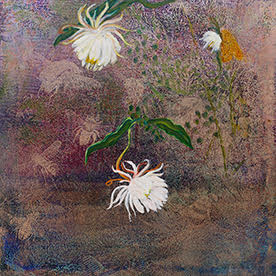
Or in contrast there are details of flowers , Queen of the Night 2021 in a recent series, “Flower Serenade: A Gift of Time” created during the pandemic.
Altogether the exhibition includes ten different series. They make a type of poem, I have mentioned several, here are all of them: Spirit Ground, Cottonwoods of the Palouse, Votives for Hanford, Essence and Artifice : Views of Spokane” Lookout/Outlook” “Time and Place”
“Luminous Frontiers” “Thicket Threshold” Polarities: Patterns in Time 1880- 2016 2.3 Degrees Fahrenheit, ” And Then Again: Rifts on the Forest and Time””Flower Serenade: A Gift of Time”
Several stand out as engaging specific places, for example the Cottonwoods of the Palouse, 1993 – 1995, painted while Robillard was on the faculty at Washington State University. There are hardly any trees in that region, but she found these beautiful cottonwoods to celebrate. ( Apparently they are no longer there)

Two of the most striking and specific series are “Votives for Hanford,” and “Lookout/Outlook.”

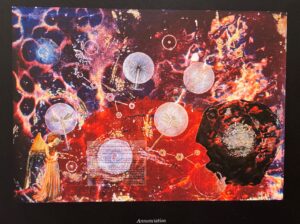
In the Hanford Series, here in Annunciation, we see a vision of holocaust in reds and blues, a flaming earth. The artist faces the intractable problem of nuclear waste with angels as witnesses to our “enchantment with invisible powers, questioning the omnipotent attitude of human beings creating a product that will have to be safeguarded for a millennium. “
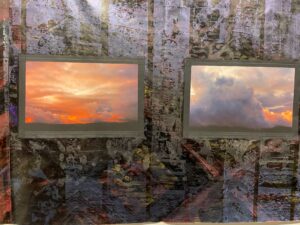
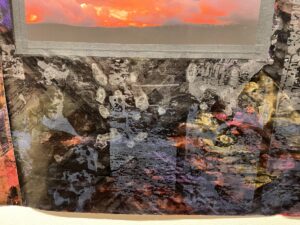
Detail of textures in background
“Lookout/Outlook” 1996-2009 depicts forest fire look out towers where the artist stayed for a summer. We see a panoramic view in small digital photographs suggesting a flaming landscape against a subtle background based on filigree patterns from medieval stonewalls. Robillard points out that the lookout towers are now anachronistic, replaced by digital surveillance.
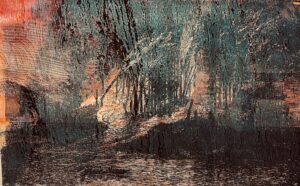
Other themes are more general but address the planetary crisis as in Conflagrations and Rain from the series Polarities: Patterns in Time 1880- 2016 2.3 Degrees Fahrenheit, 2016
The artist states: ” a mix of observation and appropriations seeking to layer sensual, tactile images that encourage the viewer to ponder the future of this planet. . . . I juxtapose flat and iridescent colors with screen printing and sand and carve each layer to create a visual history. ”
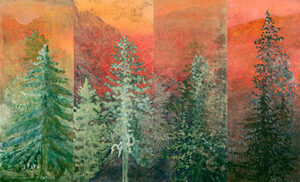
Pillars: Trees in the Hills from the series And Then Again: Rifts on the Forest and Time, 2017
Robillard sees these tall trees as “Stand -in for the people who have gone and will go before. They are pillars and graceful sentries”
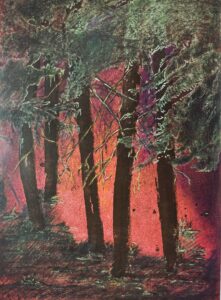
Thicket/Threshold I 1989 from series Thicket Threshold
This intense work suggests nature under stress from fire and wind.
Many of her works ( not possible to show here) included reprinted historical prints from 19th century books on landscape. Here she connects to the generation of the pioneers, as the first to come into the pristine wilderness and deeply alter it.
Robillard’s work engages nature with a romantic passion. She celebrates its beauty, its complexity, and its fragility. The range of her themes, approaches, and techniques all center around different aspects of our stunning natural world. She gives us a new intimate yet majestic look at what is still surviving our onslaught. Hopefully, we will continue to be able to see these places, but if not, we have the paintings of Rita Robillard.